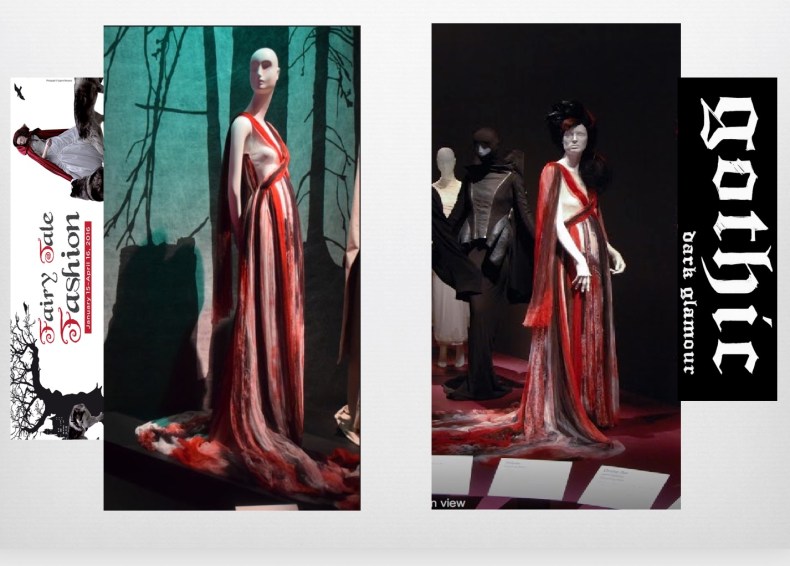
Halloween Extravaganza: Gothic Fairy-Tale Fashion
October 21, 2019
Okay, so it’s no secret that fairy tales are pretty much the ideal inspirations for fashion designers. They are public domain materials, often divorced from their cultural contexts, and filled with dreams, beauty, and imagination – all things the fashion industry wants to cultivate. Fashion is in the business of fantasy, after all, and the tales have long served as starting places for countless outfit designs, runway shows, advertisements, magazine photoshoots, and editorials.

But here’s my question: why is the fairy tale so often linked to gothic fashion in particular? I’m talking everything from leather straps and fluorescent colors to Victorian-inspired corsets and sweeping black mourning skirts – clothing that mixes the very old with the very new, embracing both the tattered and the glamorous, the horrific and the sublime, the unknown and uncanny. Frankly, it seems like the makers of gothic fairy-tale fashion have read the old stories and found the same sinister, gothic undertones I did in my dissertation! Now, frequent Carterhaugh followers will know that I’m more than a bit obsessed with the whole “gothic fairy tale” thing, but hear me out.

Let’s take a look at two major exhibitions done by the Fashion Institute of Technology’s museum. “Fairy Tale Fashion” (2016), considers the use of the fairy tale by high-end fashion designers as both direct and indirect inspiration. Seven years before it premiered, however, the same museum produced an exhibition called “Gothic: Dark Glamour” (2008-2009).
The two shows, fascinatingly, include several of the exact same outfits. In this image, you can see an example: a Rodarte dress from their Fall/Winter 2008-2009 collection. In the “Fairy Tale Fashion” exhibition, the dress was meant to evoke “Snow White,” reflecting her hair black as ebony, lips red as blood, and skin white as snow. In the “Gothic: Dark Glamour” exhibition, the war-outfit-like, potentially bloody aspects of the dress were emphasized. Coincidence? I think not.

The Gothic fairy-tale is also a frequent subject for the various visuals surrounding fashion. Consider, for example, the 2006 Vogue fashion shoot by photographer Eugenio Recuenco that selected several different fairy tales and re-imagined them in a muted, elegant, and, yes, quite Gothic style. These photographs received a great deal of attention from a variety of different sources, and they are still frequently reposted on the Internet.
You can also see these visuals in runway shows themselves. Alexander McQueen’s Fall/Winter 2008-2009 collection, created by McQueen himself before he died, was entitled “The Girl Who Lived in the Tree.” Inspired by fairy-tale motifs, McQueen designed both the collection and its runway show around the idea of a girl who lives in a tree and wears only black clothing. When she decides to come down to the earth, her wardrobe gradually becomes more and more colorful and dramatic, though still quite Gothic overall. Writing a fairy tale around his own, highly gothic fashion designs allowed McQueen to merge the two in an unexpectedly fresh way, resulting in a haunting, enchanting runway show.
As you can see in the above clip, the clothing and atmosphere depicted is certainly McQueen’s signature Gothic style… but strikingly fairy-tale-like as well. The center tree, with its otherworldly, fae glow, adds a particularly fairy-tale touch to a gothic story written through clothing.

Gothic fairy-tale fashion, my friends!
This isn’t just a phenomenon based in high fashion either though. I would point in particular to the recent boom of “Strega” fashion – outfits designed to evoke the witch in her various forms, many of which are quite gothic. Observe Sara and me doing our best strega looks ;).
There is also the “Gothic Lolita” style, which originated in Japan but has since spread, which also frequently blends the gothic and the fairy tale, drawing particularly and consciously on that unexpected juxtaposition of the perceived “innocence” of the fairy tale and the macabre of the gothic.

And then, of course, it’s also worth noting that stores like Hot Topic, QVC, and Kohls have, in the last few years, created fashion tie-ins with fairy tale films like Maleficent and Snow White and the Huntsman, each stressing a more price-friendly gothic style. Fake leather, rhinestones, and inexpensive fabrics are manipulated to give a sense of the gothic fashion that dominates the fairy-tale films’ inspiration.

Frankly, for obvious reasons, I just can’t get enough of it :). Have you seen any wonderful examples of Gothic fairy-tale fashion? Let me know in the comments!

P.S. Our $25 Halloween Mini-Course is still open for enrollment! We’ve got over 100 people joining us for all kinds of magic and mischief this year… don’t miss out!!














*swoon* I just LOVE gothic fairy tale fashion. It’s my kind of goth, AND my kind of frou-frou 🙂 To me, it’s the rock and roll side of fairy tales and faeries, and I’m very rock and roll oriented!
Totally agree!! <3!
I’m a Goth who has found that “gothic fairy tale” was definitely a vibe in 80s era Goth rock, alt music, and especially in ethereal wave. Seriously, just listen to Siouxsie and the Banshees songs like “Spellbound”, “Green Fingers”, “Red Over White”, or “Blow the House Down” or watch the music videos.
My entire aesthetic is based upon this ideal of Ethereal Goth and Woodland Goth. That whole Strawberry Switchblade, Siouxsie Sioux, and Danielle Dax (who was in Angela Carter’s The Company of Wolves!) thing is definitely my style. I’ve got a girly-Goth Mexican princess-faerie-ballerina vibe going on (yes, I am also Mexican and a dancer).